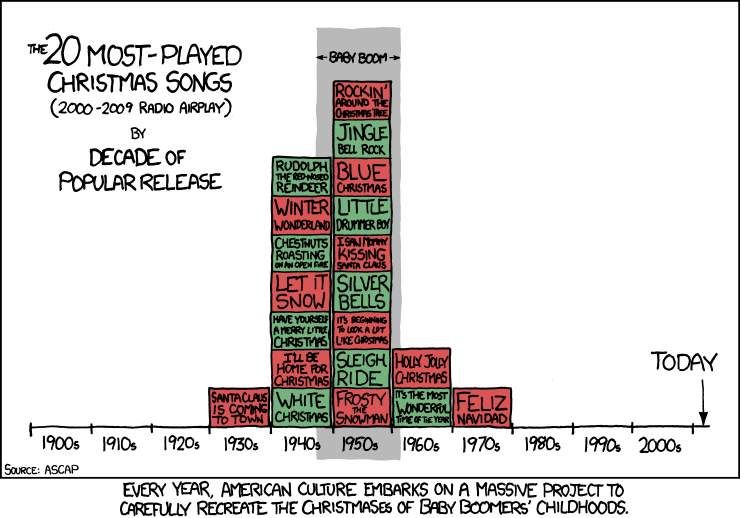The ambiguity of the Classic/Modern distinction, as I briefly alluded to in my
last post, is a subject that warrants further investigation. Alternatively, you could ignore it and choose to lead a normal life. But I'm writing a Christmas Music blog so I think that ship has sailed.
You've probably been thinking, "this Christmas blog is alright, but he hasn't mentioned Mariah Carey once, what the @#$%#$%^&$%." Well, there's good reason for that. Let me explain.
As you know, the format here is to pick a classic Christmas song and find the best modern remakes. Thus far, making the distinction has been fairly easy considering that a majority of the songs I've covered were written in the 1950s. In fact, if you take a look at the most-played Christmas songs, most, if not
all of them, are from that era (
Figure 1, xkcd).
The past few decades have been comparatively weak from a holiday music standpoint. So where exactly does one draw the line between old and new? Enter the Queen of Christmas, Mariah Carey.
I certainly don't hesitate to call Mariah Carey's
All I Want For Christmas Is You a Christmas classic and I'm sure most of my readers would agree. So is 1994 the cut-off? Should we date Christmas albums as BMC and AMC (Before and After Mariah Carey)? I've pondered this longer than I like to admit...and I think the answer might be
yes.
I don't mean to say that AIWFC was the first in a long line of "modern classics." Though her single has certainly inspired an increase in pop Christmas albums, it still stands as a statistical outlier in the recent history of Christmas music (it's the 11th Best Selling Song of all time!). It's difficult to group it with more current albums, when no other original holiday single has come close to its popularity.
What Mariah Carey's uptempo love song did accomplish, is smoothing the transition between the classics of the 1950's with 20th Century pop music. Next time you listen, pay close attention to many of the 50's and 60's stylistic influences. The back-up vocals, for example, are very 'doo-wop-esque.' It was, perhaps, this fusion of styles that helped her grab multi-generational attention. The strong, female pop/R&B vocals resonated with younger crowds while the musical nod to traditional Christmas music appealed to the Baby Boomers. One critic attributed the song's lasting popularity to the difficulty one faces in identifying it with a specific era of music (Annie Zaleksi, The A.V. Club).
 |
| Lasting Popularity of All I Want For Christmas Is You |
Mariah Carey took an immense risk releasing a Christmas album right as her career took-off, but unlike the half-hearted efforts we get from many of today's artists, she put her heart and soul into this album. She decorated her entire house in Christmas decor in the middle of August to make sure her excitement came across in the vocals. "As Sasha Frere-Jones of The New Yorker said...[it's] 'one of the few worthy modern additions to the holiday canon'."
When will be get another addition to the modern suite of Christmas classics? I'm not sure (though I'm keeping my eye on Ariana Grande). I suppose if economic prosperity was any indicator, we could've predicted the Baby Boomers would have 20-30 enduring songs from their childhood and the Millenials' just the one. Oh well.
Without further ado,
All I Want for Christmas is You.
